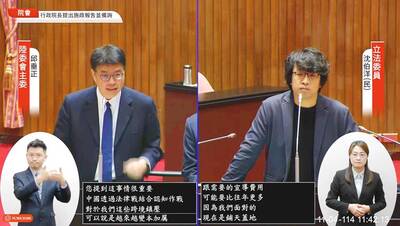Taiwanese netizens and politicians yesterday mocked a Chinese plan to build a transportation network linking Beijing and Taipei, calling it “science fiction” and “daydreaming.”
Their comments were in reaction to the Chinese State Council’s release last week of its “Guidelines on the National Comprehensive Transportation Network Plan,” which include several proposed transportation links, with one map showing a line running from China’s Jingjinji Metropolitan Region (Beijing-Tianjin-Hebei) across the Taiwan Strait to Taipei.
“This is the Chinese leadership daydreaming again of [fulfilling its] fantasy of extending China’s transportation network to Taiwan. I suggest people regard it as science fiction,” Democratic Progressive Party (DPP) Legislator Wang Ting-yu (王定宇) said.
“It is China’s ‘united front’ propaganda machine at work,” he added.
“[Chinese leaders] believe that by building a transportation link to Taipei, the Beijing government can claim that Taiwan falls under Chinese jurisdiction,” he said.
“In Europe, they have highway and railway networks linking many countries. These transportation networks go from the UK, France, all the way to Turkey. Does it mean that people consider all EU member states connected by transportation as belonging to one country?” he said.
The Chinese plan says the highway and railway links would be completed by 2035, with the final phase of the project connecting Fuzhou in China’s Fujian Province to Taipei through an undersea tunnel through the Taiwan Strait.
Taiwanese pundits and politicians said that would be impossible given the political divide, as well as unrealistic because of the engineering, environmental and financial difficulties.
Taiwan already has very good road networks that provide convenient access, Wang said.
“On the other hand, corruption is rife in China’s transportation sector, and many government officials have been arrested for siphoning money off highway and railway construction projects,” he said.
“I suggest China look after itself, instead of always coveting its neighboring country,” he said.
“The State Council should be more ambitious by announcing a plan to build a road linking China to the moon,” he added.
Some netizens said that the Beijing leadership is deluded and daydreaming.
“It is propaganda for their internal consumption, designed to deceive their own citizens. Taiwanese can already can see it is a hoax,” one netizen who called himself Johnny wrote.
“I suggest China build a trans-Pacific railway connecting Beijing to Washington in the US,” a netizen surnamed Liu (劉) wrote.
“This shows that the ‘One Belt, One Road’ project is China’s dream to build transportation networks to Asia, Europe and Africa, to unite all these continents under Chinese motherland’s rule,” another netizen wrote.

CALL FOR SUPPORT: President William Lai called on lawmakers across party lines to ensure the livelihood of Taiwanese and that national security is protected President William Lai (賴清德) yesterday called for bipartisan support for Taiwan’s investment in self-defense capabilities at the christening and launch of two coast guard vessels at CSBC Corp, Taiwan’s (台灣國際造船) shipyard in Kaohsiung. The Taipei (台北) is the fourth and final ship of the Chiayi-class offshore patrol vessels, and the Siraya (西拉雅) is the Coast Guard Administration’s (CGA) first-ever ocean patrol vessel, the government said. The Taipei is the fourth and final ship of the Chiayi-class offshore patrol vessels with a displacement of about 4,000 tonnes, Lai said. This ship class was ordered as a result of former president Tsai Ing-wen’s (蔡英文) 2018

‘SECRETS’: While saying China would not attack during his presidency, Donald Trump declined to say how Washington would respond if Beijing were to take military action US President Donald Trump said that China would not take military action against Taiwan while he is president, as the Chinese leaders “know the consequences.” Trump made the statement during an interview on CBS’ 60 Minutes program that aired on Sunday, a few days after his meeting with Chinese President Xi Jinping (習近平) in South Korea. “He [Xi] has openly said, and his people have openly said at meetings, ‘we would never do anything while President Trump is president,’ because they know the consequences,” Trump said in the interview. However, he repeatedly declined to say exactly how Washington would respond in

WARFARE: All sectors of society should recognize, unite, and collectively resist and condemn Beijing’s cross-border suppression, MAC Minister Chiu Chui-cheng said The number of Taiwanese detained because of legal affairs by Chinese authorities has tripled this year, as Beijing intensified its intimidation and division of Taiwanese by combining lawfare and cognitive warfare, the Mainland Affairs Council (MAC) said yesterday. MAC Minister Chiu Chui-cheng (邱垂正) made the statement in response to questions by Democratic Progressive Party (DPP) Legislator Puma Shen (沈柏洋) about the government’s response to counter Chinese public opinion warfare, lawfare and psychological warfare. Shen said he is also being investigated by China for promoting “Taiwanese independence.” He was referring to a report published on Tuesday last week by China’s state-run Xinhua news agency,

‘ADDITIONAL CONDITION’: Taiwan will work with like-minded countries to protect its right to participate in next year’s meeting, the foreign ministry said The US will “continue to press China for security arrangements and protocols that safeguard all participants when attending APEC meetings in China,” a US Department of State spokesperson said yesterday, after Beijing suggested that members must adhere to its “one China principle” to participate. “The United States insists on the full and equal participation of all APEC member economies — including Taiwan — consistent with APEC’s guidelines, rules and established practice, as affirmed by China in its offer to host in 2026,” the unnamed spokesperson said in response to media queries about China putting a “one China” principle condition on Taiwan’s